Sennelier Pigments Guide
Whites
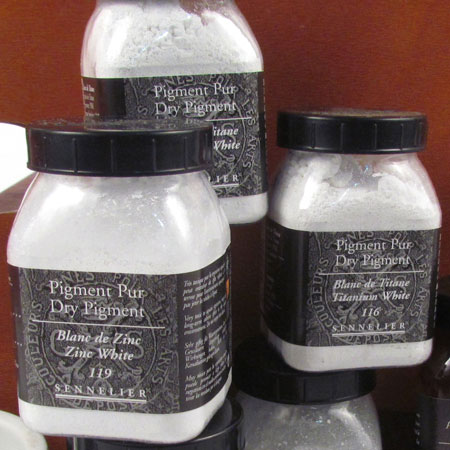
Titanium White
Titanium dioxide (rutile variety). Very lightfast. An opaque, very dense white that mixes well with all colors. An excellent all-around white appropriate for both oil- and water-based colours. The most recent of the white pigments to be developed, this pigment, which dates to about 1915, occupies an important position in the white family.
Zinc White
Zinc oxide, which dates back to 18th century painting, was first manufactured by the French chemist Courtois. A stable, non-toxic, semi-transparent pigment that mixes well with all colours. Use it in thin layers, or in combination with titanium white. Used most frequently in oil, gouache, and watercolour. Suitable for fresco.
Yellows
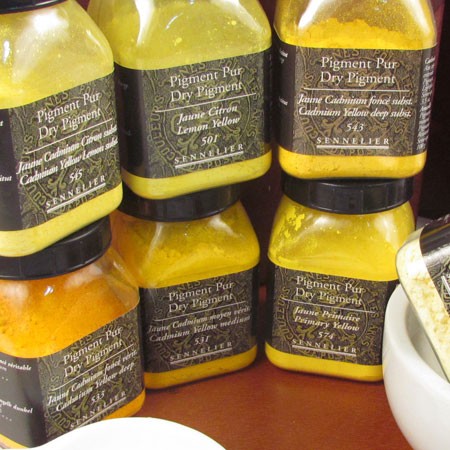
Bright Yellow
A mixture of zinc oxide, mononitrogenous “azo” yellow, and modified arylide. A warm yellow with a good lightfastness, compatible with any binder except fresco.
Cadmium Yellow Substitute
Cadmium colours, discovered in Germany in 1817 by Stromeyer, were quickly adopted by artits, who appreciated their intensity and high tinting strength. All dry pigments designated as substitutes are made from a combination of synthetic organic pigments that reproduce the genuine pigment colour, but at a much lower price. Cadmium yellow substitute is a stable compound of inert, mononitrogenous “azo” pigments and extenders. Very lightfast, it is stable in all binders : oil, acrylic, watercolour, gouache. For fresco use only genuine cadmium colours.
Cadmium Yellow
Cadmium sulfide. Mineral pigment providing an opaque intense yellow with good tinting strength and lightfastness. Suitable for all techniques. Do not mix with flake white or chrome yellows.
Chrome Yellow
Lead chromate. This pigment, predecessor of the cadmiums, provides excellent tinting strength and a solid, durable film. However, these pigments present certain negative aspects : in addition to their toxicity and poor lightfastness, they tend to darken over time. Unsuitable for fresco. Still used primarily because of its reasonable price, and as part of painting tradition. When used to mix greens, provides very deep, dense shades.
Lemon Yellow
Formerly used in the form of zinc yellow, whose weaknesses led to the formulation of lemon yellow from synthetic organic mononitrogenous “azo” pigments. Very good lightfastness. Suitable for use in all binders, and provides very stable mixtures. Good tinting strength. Not recommended for fresco.
Indian Yellow Substitute
Composition of nitrogenous “azo” pigments that reproduce the genuine Indian Yellow shade. Luminous, very lightfast, transparent pigment. Frequently employed for warming up hues. Suitable for all techniques except fresco.
Mars Yellow
Nitrogenous “azo” pigment and natural earth. At one time, this pigment was obtained from a concentrate of animal urine from India, but for more than 50 years, it has been reproduced with modern pigments. Transparent, very lightfast pigment. High tinting strength. Suitable for all techniques except fresco.
Naples Yellow Substitute
Documented by Cennino Cennini, the appearance of Naples Yellow has not been clearly established ; true Naples Yellow is a lead antimonate that was frequently employed in past centuries. Its properties have now been rediscovered. But since genuine Naples Yellow is toxic, this colour is a substitute based on zinc oxide, titanium dioxide, and mononitrogenous “azo” yellow. A luminous, very lightfast colour, this yellow yields a rich, beautiful, dense paste. Suitable in all binders, including oil, watercolour, tempera and acrylic. Not suitable for fresco.
Nickel Yellow
Nickel-titanate yellow. A vibrant yellow with a slight greenish hue. Very good tinting strength, excellent lightfastness in mixtures and shades. Can be mixed with all pigments and suitable in any binder, including fresco.
Reds
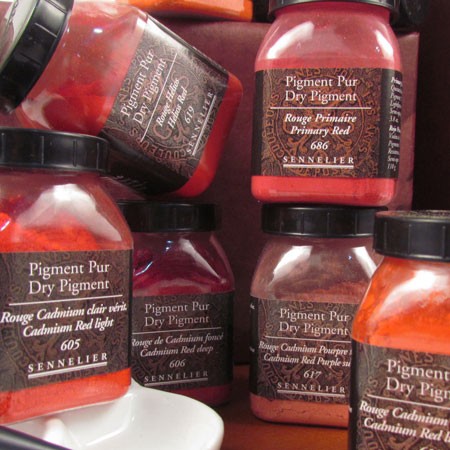
Cadmium Red Substitutes (Light, Deep, Purple, and Orange)
Nitrogenous “azo” pigments, zinc oxide, extenders. As with cadmium yellow substitutes, cadmium red substitutes are composed of several pigments reproducing the genuine cadmium shade. These colours offer : – good lightfastness – stability in mixtures in any binder Suitable for oil, gouache, watercolour, and acrylic, but not recommended for fresco.
Cadmium Red Genuine (Light, Purple, Orange and Deep)
Sulfoselenide of cadmium. Opaque mineral pigment with excellent covering power. Completely lightfast and stable in mixtures in any binder. Suitable for all techniques, including fresco. Do not mix with flake white.
Permanent Red Deep
Calcium lake and extenders. Synthetic organic red that imparts bright, intense carmine red shades. Good tinting strength, average lightfastness. Used mainly for decorative purposes. Not suitable for fresco.
Helios Red
Toluidine red. A brilliant organic red, extremely intense and luminous. High tinting strength, average lightfastness. Suitable for all techniques, including oil, gouache, watercolour, tempera and acrylic. Not suitable for fresco.
Mars Red
Iron oxide. Dark, rich brownish red. Provides a transparent film with an excellent tinting strength. Very lightfast and stable in mixtures. Suitable for all techniques, including fresco.
Venetian Red
Iron oxide. Vibrant brown with excellent colouring capacity. Very lightfast and stable in mixtures. Suitable for all techniques, especially fresco.
Quinacridone Red
Organic pigment with very high tinting strength ; very lightfast. An intense, vibrant red that is transparent and therefore outstanding for glazing. In mixtures with white, provides a luminous, delicate pink.
French Vermilion Substitute
The mineral known as Cinnabar dates back to antiquity; the Romans called it minium. In 1687, Schulte used mercury to create the Vermilion pigment, named after “Vermeil” (bright red). As a result of its toxicity and its poor stability, notably in mixtures with flake white, artists since the early 20th century have increasingly replaced it with this substitute, made from nitrogenous “azo” and extenders. Bright, luminous orange-red with high tinting strength. Good lightfastness. Suitable for all techniques except fresco.
Chinese Vermilion Substitute
Toluidine red and extenders. Deep, lake-like red. Average lightfastness. Suitable for all technique except fresco.
Lakes
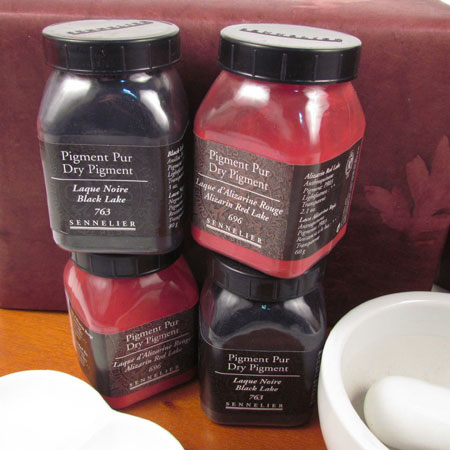
Synthetic alizarin was formulated from tar in 1868 by Groebe and Libermann. It perfectly reproduces Madder (Garance), traditionally extracted from the ground root “Rubian tinctorium”.
Alizarin Scarlet Lake
Nitrogenous “azo” lake. Bright, extremely luminous, transparent red. Principally used in oil, watercolour, tempera and acrylic. Average lightfastness. In oil, used primarily in glazes, because when applied in thick pastes ,it is prone to cracking. Not recommended for fresco.
Alizarin Red Lake
Alizarin lake on aluminium hydrate base. Deep, transparent red with a carmine hue. Average lightfastness. High tinting strength. When used in oil, has a tendency to crack. Slow drying. Suitable for all techniques, except fresco.
Black Lake
Synthetic aniline black that is velvety and intense. In tints, takes on a slightly bluish hue. Average lightfastness. Not recommended for fresco.
Solferino Lake (Tyrian Rose)
Calcified aluminium hydrate base lake. Very bright pink. Poor lightfastness, excellent tinting strength. Because of its fugitive nature, use with discretion. Not suitable for fresco.
Violets
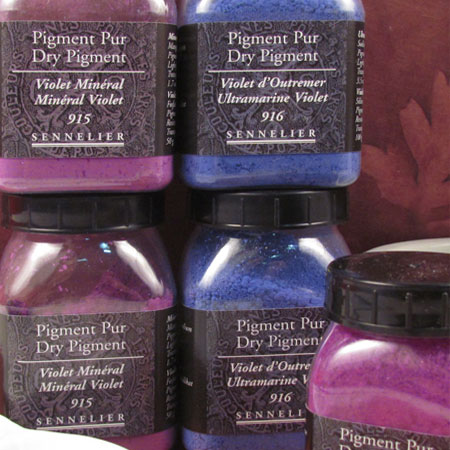
Cobalt Violet Deep
Cobalt phosphate. Dark purple hue, very lightfast and stable in mixtures. Low tinting strength but good covering power. Recommended for fresco. Mineral Violet Manganese phosphate.
Red-purple Hue
Good covering power, average tinting strength, good lightfastness. Suitable for all mediums except fresco and water-based techniques.
Ultramarine Violet
Silico aluminate of sodium. Mineral pigment. Suitable for all techniques including fresco. Low tinting strength. Provides a transparent, muted, red-violet film. Very lightfast.
Blues

Cerulean Blue Substitute
Cerulean Blue Substitute is based on barium sulfate and phthalocyanine blue. This hue, an imitation of genuine cerulean blue, provides remarkable lightfastness. Very high tinting strength. Suitable for all techniques.
Cerulean Blue
Cobalt stannate. Invented around 1850, under the name celestial blue. Derived from cobalt blue, in a harmonious, blue-green hue. Opaque, very lightfast, stable in mixtures. Suitable for all techniques. Very precious pigment.
Cobalt Blue
Cobalt aluminate. In the 19th century, the French chemist Thénard successfully obtained this pigment from a natural mineral. A very pure blue shade. Excellent lightfastness, very stable in mixtures. Suitable for all techniques.
Ultramarine Blue Light
Silico aluminate of sodium polysulfides. In 1828, the chemist Guillemet synthetically reproduced the natural colour of Lapis Lazuli, which had been in use since antiquity. Variations in the hue result from the size of its microparticles. The preparation of ultramarine blue is quite complex, and varies according to the desired individual shade. Luminous, intense blue that approaches the appearance of cobalt blue, and provides bright, pleasant effects in shading. Mixes well with other pigments, but, since it contains sulfur, should not be mixed with flake White or chrome based pigments. Suitable for all techniques.
Ultramarine Blue Deep
Silico aluminate of sodium polysulfides. Preparation identical to that of Ultramarine Blue light. A deep, very intense shade, more purple than
Ultramarine Blue light
Very lightfast. An important colour on most artists’ palettes. Suitable for fresco.
Prussian Blue
Ferric ferrocyanide. Discovered in Prussia at the beginning of the 18th century. Difficult to grind and moisten. Very high tinting strength. Good lightfastness (contrary to its reputation) except in oil colours, where it tends to darken. Strong, transparent tone. Dries out oily binders. Not suitable for fresco.
Indigo Blue
Indanthrone blue. Synthetic organic pigment. Reproduction of true indigo, which comes from an Indian plant. Very high tinting strength. Remarkable lightfastness. Provides a semi-opaque film. A deep, intense blue suitable for all binders, except fresco.
Azure (Hue)
Formerly produced in the form of Manganese Blue Genuine until the dangers of its manufacture led to its disappearance. Azure is made from synthetic organic pigments phthalocyanine blue and barium sulphate. Very lightfast. Suitable for all techniques, except fresco. Provides a bright, luminous, turquoise blue shade.
Cobalt Blue Deep
Cobalt aluminate. The varying temperatures at which it is calcinated (cooked) accounts for the many different shades of Cobalt Blue). Bright, deep blue with excellent lightfast properties that mixes very well with other pigments. Suitable for all techniques.
Cobalt Turquoise
Cobalt aluminate. A unique turquoise hue whose brightness cannot be matched in other mixtures. Excellent lightfastness. To retain its unique vividness in oil painting, use it with a non-yellowing oil (safflower).
Phthalocyanine Blue
Pure synthetic organic pigment with exceptionally high tinting strength. Very good lightfastness. Suitable for all techniques (except fresco). Because of its powerful tinting strength, use it with discretion. A transparent hue well suited to glazing techniques. Provides a blue palette ranging from pale sky blue to dark, sombre tones similar to Prussian blue. In mixtures, use it to create an infinite range of greens.
Greens
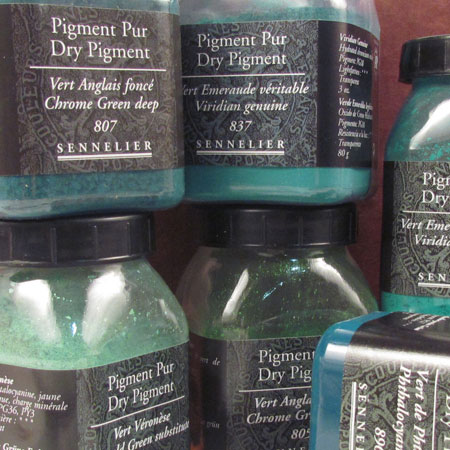
English Green Light
Nitrogenous “azo” and Phthalocyanine. Provides a softly luminous green. High tinting strength. Good lightfastness and stability in mixtures. Not recommended for fresco.
English Green Deep
Nitrogenous “azo” and Phthalocyanine. Deep bluish green. Powerful tinting strength. Good lightfastness, stable in mixtures. Not recommended for fresco.
Baryte Green
Chromate of baryte, Phthalocyanine, and strontium chromate. Pale, luminous green with excellent covering capacity. Average lightfastness. Because it is classified as toxic, this pigment should not be used in powdered form. Good drying properties when used in oil. Suitable for all techniques. Not recommended for fresco.
Cobalt Green Light
Combination of zinc and cobalt green. Cold, pale green with a lovely tonality, pulling toward turquoise. A pure colour with good covering power, low tinting strength. Very lightfast and stable in mixture. Suitable for all techniques, including fresco.
Emerald Green Substitute
Phthalocyanine and extenders. Close in appearance to genuine emerald green, but at a much more reasonable price. Luminous green with high tinting strength. Good lightfastness and stability in mixtures. Not recommended for fresco.
Emerald Green
In the 19th century, Pannetier created this transparent shade, which was rapidly adopted by painters for its remarkable properties, especially for glazing. “Hydrated” chromium oxide. Deep, intense green. Very good lightfastness, stable in mixture. Especially well-suited to oil glazes. Less vibrant, and with a lower tinting strength than Emerald Green Substitute. Suitable for all techniques and with all binders, especially fresco. Avoid applying it in very thick layers.
Chromium Oxide Green
Anhydrous Chromium Oxide. Dull green hue. Excellent tinting strength and covering power. Very good lightfastness and stability in mixtures. When used in oil, provides a very buttery, easy-to-use paste. Recommended for fresco.
Veronese Green
Genuine Veronese Green, which is a copper arsenate, is quite toxic. This bright, luminous hue reproduces the original with modern pigments-mononitrogenous “azo”, Phthalocyanine, and extenders. Pale green tone. Luminous, good covering power, low tinting strength. Very lightfast. Suitable in all binders, except fresco. Phthalocyanine Green Synthetic organic pigment. Its characteristics are identical to those of Phthalocyanine Blue, but in a brilliant rich green hue.
Earths

Natural earths (Raw Sienna, Burnt Sienna, Raw Umber, Burnt Umber, Green Earth) All the siennas, umbers, and green earths are entirely natural and come from Italian soil. They are all natural iron oxides. The natural earth colours are completely lightfast and stable in mixtures. Colours referred to as “burnt” come from calcified native earth. Siennas and umbers require a great amount of oil in grinding. Since earths naturally have excellent drying properties, avoid adding drying agents. Earth pigments are suitable for all techniques, and are recommended for fresco.
Ochres
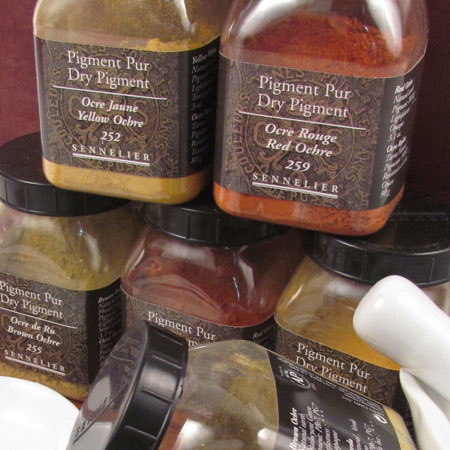
Ochres have been in use since prehistory. These coloured clays, which contain iron oxide found in the earth, generally come from France and Italy. These natural pigments are perfectly lightfast and suitable for all techniques, especially for fresco (with the exception of brown ochre).
Yellow Ochre
Natural, clay-base yellow. A warm, slightly transparent colour.
Red Ochre
Calcified yellow ochre.
Brown Ochre
Rich, dark brown formulated from natural clays and synthetic pigments. Not recommended for fresco.
Browns
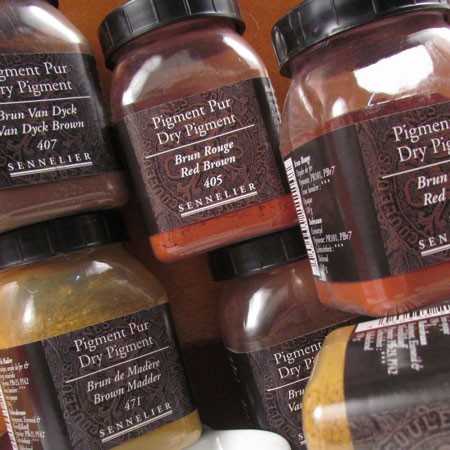
Madder Brown
Transparent “azo” pigment and extenders. Very intense, transparent, reddish brown with high tinting strength. Suitable for all techniques, except fresco.
Red Brown
Iron oxide. Good covering brown, very lightfast and stable in mixtures. Recommended for all techniques including fresco.
Van Dyck Brown
Iron oxide.
Purple brown
Very lightfast and stable in mixtures. Suitable for all techniques, including fresco.
Blacks
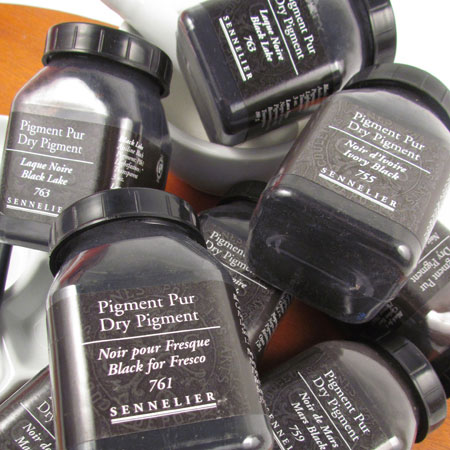
In its pure state, black does not literally exist. In fact, all substances that appear black actually have the capacity to absorb the entire range of colours found in white light.
Ivory Black
Carbon from animal bones calcified in a vase, rather than ivory tusks as was in the past. A warm, intense black that turns brownish when mixed with white. Very good lightfastness. In oil painting, requires large amouts of binder. Does not dry well. Suitable for all techniques, but in fresco, Black for Fresco is preferable.
Black for Fresco
Carbon smoke soot. This black works especially well for fresco, for which it is primarily used, but is entirely suitable for all techniques. Very lightfast.
Mars Black
Iron oxide. This synthetic black is durable and very lightfast. Creates cool gray shades. Suitable for all techniques including fresco.
Primary
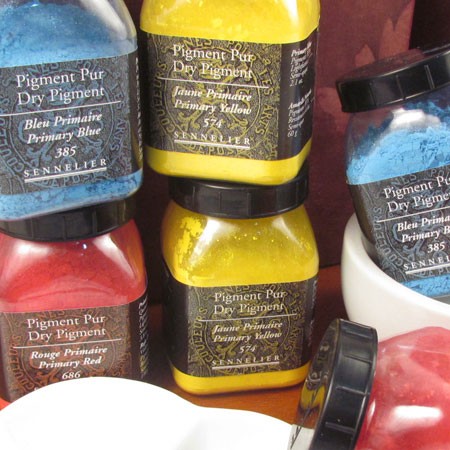
This unique range of primaries was especially developed for the Sennelier range of dry pigments. Each of these hues was formulated to offer exactly the same tinting strength, so in mixtures, they allow you to create medium hue secondary colours:
1 part yellow + 1 part red = medium orange hue.
1 part red + 1 part blue = medium purple hue.
1 part yellow + 1 part blue = medium green hue.
As a result of the equal intensity of these three primaries, the progressive mixtures of hues, mixed, remain distinct. Therefore, it is not necessary to add white to maintain the purity of these mixtures. All three have excellent lightfastness.
Primary Blue
Phthalocyanine pigment and extenders. Very lightfast. Good tinting strength. Suitable for all techniques, including oil, gouache, watercolour, tempera and acrylic.
Primary Yellow
Nitrogenous “azo” pigment and extenders. Very lightfast. Good tinting strength. Can be used in all techniques : oil, gouache, watercolour, tempera and acrylic.
Primary Red
Quinacridone pigment and extenders. Very lightfast. Good tinting strength. Suitable for all techniques, including oil, gouache, watercolour, tempera and acrylic.
Speciality - Metallic, Iridescent, Phosphorescent, Fluorescent

Metallics
Copper - Red Gold - Yellow Gold
Metallic pigments produced from metal alloy powders that have undergone surface treatment. Suitable for all oil and water-based binders except acrylic and fresco. Apply a varnish over metallic colors to prevent oxidation.
Iridescent Pigments
Titanium dioxide. Iridescent pigments undergo surface treatment with mica ; their level of iridescence varies according to the mica content. As a result of reflections and light interference, they may take on very different colours. Extremely lightfast, excellent covering power, non-toxic. Used for a wide range of applications, including cosmetics. Suitable in all binders, including oils, vinyl paints, resins, etc… Avoid grinding iridescent pigments ; grinding may destroy their “mother-of-pearl” effect.
Fluorescent Pigments
Fluorescence, which results from the pigments’ ability to transform light, provides unique tonalities that only exist outside nature. These pigments are extremely unstable, and are recommended only for temporary artworks. Very poor lightfastness. Not recommended for fresco.
Phosphorescent
Inorganic, phosphorescent Zinc sulphide powders. Recommended for use with water-based binders (except fresco). Since excessive grinding weakens their phosphorescent qualities, pigments should be mixed gently with a binder, or ground lightly. Humidity and ultraviolet rays can darken these pigments. If the colours are exposed to direct light, keep the humidity of the environment under 50%. Applied in favourable conditions, the special properties of these pigments can last for years.
